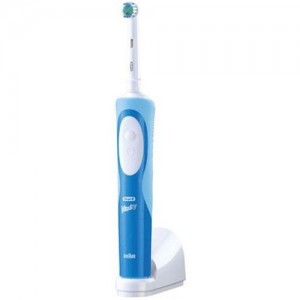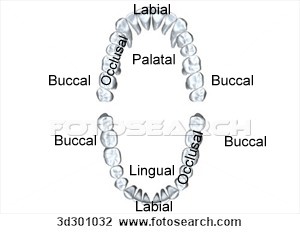 Electric Toothbrushes or Power Toothbrushes
Electric Toothbrushes or Power Toothbrushes
The first toothbrush powered by electricity was developed by Bermann and Woog in Switzerland and was introduced in the US in 1960 as the “Broxodent”. In 1961, a cordless tooth brush model was introduce in General Electric. These early powered toothbrush consisted of an electric motor encased in a plastic and detachable toothbrushes. They used battery or alternating current to function. Studies of these early electric toothbrush showed that there was no difference in plaque removal when compared to a manual toothbrush, however when assessing effects on controlling gingivitis, results were mixed.
Since 1980, there has been many new electric toothbrush advances. Top rated electric toothbrushes include the following, Braun Oral-B Ultra Plaque Remover, Braun Oral-B 3D, Interplak, Rotadent and Sonicare or Ultrasound Toothbrush. Although these brands have different mechanism of action, they are safe when applied to the gums and teeth. Studies show that modern power toothbrushes are more effective than manual toothbrush in removing plaque and reducing gum disease.
Who would a dentist recommend electric toothbrush too?
Those who are physically disabled will benefit from these electric toothbrush. Those with Parkinson or Down syndrome can use these electric toothbrushes for effective brushing or plaque removal. Electric toothbrushes are also recommended for children or adults who have difficulty brushing for more than 2 minutes. This is because most individuals brush their teeth for 45 to 60 seconds, electric toothbrush with timers provide the means for clients to asses time spent brushing. Those which brushes too hard and cause abrasion or wearing off the surfaces of the teeth are also recommende to use electric toothbrushes. This is because electric tooth brushing has been shown to use much less force than manual tooth brushing. Electric toothbrushes are also recommended for people with gum disease. Receding gums electric toothbrush helps gum disease because it exerts a massaging effect on the gums, hence better blood circulation, less trauma resulting in healthy gums. Also recommended for patients with fixed orthodontic appliances.
Tooth brushing Methods
Both manual toothbrushes and power toothbrushes have greater benefit when dental professionals or dentist provide advice and instruction in methods of using these devices. Many different methods of tooth brushing have been developed. The best methods dislodges plaque (food debris or tar tar) and debris, stimulate gums and deliver fluoridated dentifrice (toothpaste) to the tooth surface.
Toothbrushing Instructions
 SEQUENCE , Regardless of the specific methods employed to brush, clients must basically brush thoroughly. Many patients spend too little time brushing or they brush haphazardly. Patients should develop a proper sequence of brushing. This is an example of brushing sequence that should be followed just to ensure that all the tooth surfaces are covered. Refer to the diagram for better understanding.Start with the upper arch of the teeth. Posteriorly or at the back on the buccal surfaces, coming round the arch to the front or anterior labial surfaces. Than proceed to brush the anterior and posterior palatal surfaces. Finally brush all upper occlusal surfaces.Now for the lower arch, start on the posterior or back buccal surface, than go round the arch to the anterior labial surface. Proceed on to the lingual surface of the teeth. Than brush the occlusal srufaces of all the teeh.
SEQUENCE , Regardless of the specific methods employed to brush, clients must basically brush thoroughly. Many patients spend too little time brushing or they brush haphazardly. Patients should develop a proper sequence of brushing. This is an example of brushing sequence that should be followed just to ensure that all the tooth surfaces are covered. Refer to the diagram for better understanding.Start with the upper arch of the teeth. Posteriorly or at the back on the buccal surfaces, coming round the arch to the front or anterior labial surfaces. Than proceed to brush the anterior and posterior palatal surfaces. Finally brush all upper occlusal surfaces.Now for the lower arch, start on the posterior or back buccal surface, than go round the arch to the anterior labial surface. Proceed on to the lingual surface of the teeth. Than brush the occlusal srufaces of all the teeh.
DURATION , Duration of the toothbrushing also should be stressed during toothbrushing instruction. It has been shown that the average brushing time varies from approximately 45- 60 seconds. Dentist frequently recommend patients to brush their teeth for 3 minutes, however if proper brushing methods are used, than 2 minutes would be sufficient.
FREQUENCY, In addition to thoroughness of toothbrushing, frequency or the number of times a patient brushes a day must be considered. Theoretically, if a patient uses a proper brushing method and follows correct instruction , brushing once a day would be sufficient. Unfortunately, most people cannot attain the goal of 100 % plaque removal. Therefore it is generally recommended that patients brush at least twice daily. Once in the morning and once at night before bed.
 Toothbrushing Methods
Toothbrushing Methods
BASS METHOD, Bass brushing method or sulcular method has been universally accepted as the most effective:, therefore it is the most commonly recommended method. The toothbrush handle is grasped by the palm. The toothbrush bristles are directed apically( toward the root portion of the tooth) and angled 45 degrees to the long axis of the tooth. Gentle force is applied to insert the bristle into and in between the gum sulcus. The strokes are given with gentle and vibratory motion. Approximately 10 strokes are given. Than the next tooth and area is cleaned.
STILLMAN’S METHOD, Stillman’s brushing method is almost similar to the Bass method of brushing. But there is one significant difference, the bristles are not angulated into the gingival sulcus like the Bass method. Therefore it is very appropriate for patients with gum recessions.
HORIZONTAL SCRUB, Horizontal scrub brushing method or technique is the most commonly used method by most untrained patients. It is considered a bad method because the horizontal scrubbing method causes trauma to the gums and abrasion or wearing off of tooth surfaces.
CIRCULAR METHOD, The circular brushing method may be recommended as an easy to learn first technique for young children. With teeth closed, the upper and lower teeth are brushed simultaneously with large and small circular strokes.
Pingback: Most asked questions on Dental Implants part 2 | Intelligent Dental
Pingback: Most asked questions on Dental Implants part 3 | Intelligent Dental
Pingback: Oral Health: Relationship between the body and mouth I | Intelligent Dental
Pingback: How to Identify Risk Factors for Gingivitis | Intelligent Dental